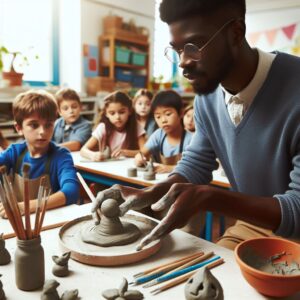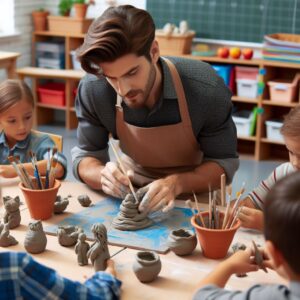Table Of Contents
- 1 Introduction to Clay Sculpting
- 1.1 What is clay sculpting?
- 1.2 Types of clay
- 1.3 Tips for clay sculpting
- 1.4 Deciphering Clay Sculpting Techniques for KS2 Learners
- 1.5 Understanding KS2 Curriculum Goals:
- 1.6 Engaging KS2 Students with Clay Sculpting Techniques:
- 1.7 Resources and Tools for KS2 Clay Sculptors:
- 1.8 Molding Young Minds: Practical Clay Sculpting Activities for KS2 Learners
- 1.9 Clay Sculpting Activities for KS2:
- 1.10 Sculpting Conclusions and FAQs for Clay-Curious KS2 Learners
- 1.11 Key Takeaways:
- 1.12 Frequently Asked Questions:
Introduction to Clay Sculpting
Clay sculpting is a great way to express your creativity and make beautiful, unique pieces of art. It is a relatively easy art form to get started with, and it can be enjoyed by people of all ages.
What is clay sculpting?

Clay sculpting is the art of shaping clay into different forms. Clay is a malleable material that can be easily molded and manipulated. It comes in a variety of colors and textures, and it can be used to create a wide range of objects, including figurines, sculptures, jewelry, and pottery.
Types of clay
There are two main types of clay used for sculpting: air-dry clay and polymer clay.
- Air-dry clay hardens at room temperature, without the need for a kiln. It is a good choice for beginners, as it is easy to work with and relatively inexpensive.
- Polymer clay is a synthetic clay that can be baked in an oven to harden. It is more durable than air-dry clay, and it can be used to create more intricate details.
-
Clay sculpting techniques
There are many different techniques that can be used for clay sculpting. Some basic techniques include:
- Pinching: This technique involves using your fingers to shape the clay into simple forms, such as balls, cylinders, and cones.
- Coiling: This technique involves rolling the clay into long, thin ropes that are then joined together to create shapes.
- Slab construction: This technique involves rolling out the clay into flat sheets that are then cut, shaped, and assembled to create objects.
Tips for clay sculpting
Here are a few tips for clay sculpting:
- Start with a small amount of clay. It is easier to work with a small amount of clay at a time.
- Use a work surface that is clean and smooth. This will help to prevent the clay from sticking.
- Keep your hands moist. This will help to prevent the clay from sticking to your hands.
- Use tools to help you shape the clay. There are a variety of tools available that can make it easier to create intricate details.
- Be patient. It takes time and practice to master clay sculpting.
Clay sculpting is a fun and rewarding art form that can be enjoyed by people of all ages. With a little practice, you will be able to create beautiful and unique pieces of art.
Deciphering Clay Sculpting Techniques for KS2 Learners

In our previous session, we explored the fascinating world of clay sculpting, introducing its essence and basic details. Now, let’s delve deeper into the specific techniques and resources relevant to KS2 learners, empowering them to embark on their creative journey with clay!
Understanding KS2 Curriculum Goals:
The KS2 curriculum aims to equip children with a foundational understanding and appreciation for art and design. Clay sculpting serves as a potent tool for achieving this objective, allowing children to:
- Develop their fine motor skills and hand-eye coordination through manipulating the clay.
- Explore and experiment with different techniques and materials, fostering their creative thinking and problem-solving abilities.
- Express their individuality and emotions through the creation of unique and personal sculptures.
- Gain an appreciation for different cultures and artistic styles through researching and exploring diverse clay sculpting traditions.
Engaging KS2 Students with Clay Sculpting Techniques:

Here are some captivating and age-appropriate clay sculpting techniques to engage KS2 learners:
1. Pinch and Poke:
This introductory technique involves pinching the clay with thumb and fingers, creating basic shapes like spheres, cones, and cylinders. Encourage students to experiment with different sizes and textures, incorporating natural objects like leaves and twigs for added visual interest.
2. Roll and Coil:
Introduce the concept of rolling clay into long snakes, then coiling them together to create intricate forms like animals, flowers, or even miniature structures. This technique encourages collaboration and teamwork as students can build larger sculptures together.
3. Slab Construction:
Rolling out clay into flat sheets opens up a world of creative possibilities. Students can cut shapes using cookie cutters or freehand, assemble them to build 3D objects, and explore decorative techniques like embossing and scoring. This technique promotes spatial reasoning and planning skills.
4. Texture Mania:
Let students explore the world of texture by utilizing various tools like textured combs, rollers, and stamps. Encourage them to experiment with different textures and patterns, creating unique surfaces that add depth and dimension to their sculptures.
5. Storytelling through Clay:
Challenge students to translate their favorite stories or characters into clay sculptures. This technique promotes literacy and encourages creative interpretation, allowing them to express their understanding of the story in a tangible and engaging way.
Resources and Tools for KS2 Clay Sculptors:
- Age-appropriate clay: Opt for air-dry clay or oven-bake polymer clay, depending on your preference and access to resources.
- Basic sculpting tools: Provide a set of sculpting tools like knives, spatulas, and loop tools for shaping and adding details.
- Rolling pins and mats: These tools help students roll out clay evenly and ensure consistent thickness for various projects.
- Texture tools: Encourage exploration with textured combs, rollers, stamps, and other tools to add visual interest and depth.
- Craft materials: Provide additional materials like buttons, beads, sequins, and fabric scraps to embellish and personalize sculptures.
- Books and online resources: Offer access to age-appropriate books, websites, and tutorials that provide step-by-step instructions and creative inspiration.
By incorporating these engaging techniques, fostering a supportive learning environment, and providing access to appropriate resources, we can empower KS2 learners to embark on a fulfilling journey of discovery through clay sculpting.
Now next, we’ll delve deeper into the practical aspects of implementing these techniques, providing valuable tips for teachers and parents to guide their young artists on their creative clay sculpting adventures.
Molding Young Minds: Practical Clay Sculpting Activities for KS2 Learners
Now that we have explored the engaging clay sculpting techniques suitable for KS2 learners, it’s time to delve into the practical aspects of implementing these techniques in the classroom or at home.
Clay Sculpting Activities for KS2:
1. Pinch and Poke Creatures:
- Materials: Air-dry clay, googly eyes, toothpicks, buttons, feathers (optional)
- Activity: Guide students to pinch and poke clay into basic shapes to create different creatures like animals, monsters, or mythical beasts. Encourage them to add googly eyes, toothpicks for limbs, buttons for details, and feathers for wings or tails.
- Learning outcomes: Develops fine motor skills, hand-eye coordination, and creative thinking.
2. Coil and Build Collaborative Sculptures:
- Materials: Air-dry clay, large sheet, cardboard base (optional)
- Activity: Divide students into groups and provide each group with a large sheet and some clay. Challenge them to work together to roll and coil the clay, building a collaborative sculpture on the sheet or a cardboard base. Encourage discussions and problem-solving as they brainstorm and build their creation.
- Learning outcomes: Develops teamwork, communication, problem-solving skills, and spatial reasoning.
3. Slab Construction Picture Frames:
- Materials: Rolling pin, cookie cutters, craft knife, scoring tool, slip (liquid clay), paints, paint brushes
- Activity: Guide students to roll out clay and use cookie cutters or freehand cutting to create shapes for their picture frames. Encourage them to add decorative elements using the scoring tool. Once assembled using slip, allow the frames to dry and then paint them with vibrant colors and patterns.
- Learning outcomes: Develops fine motor skills, hand-eye coordination, planning, and spatial reasoning.
4. Textured Monsters and Landscapes:
- Materials: Air-dry clay, textured combs, rollers, stamps, buttons, leaves, twigs
- Activity: Let students experiment with various textured tools and natural objects to create unique surfaces on their clay creations. Encourage them to build monsters with textured skin or create landscapes with textured hills, valleys, and water surfaces.
- Learning outcomes: Develops sensory awareness, fine motor skills, and creative exploration.
5. Story Sculptures:
- Materials: Air-dry clay, sculpting tools, craft materials (optional)
- Activity: Challenge students to choose their favorite story or character and sculpt a scene or character using clay. Encourage them to use their imagination and creativity to bring the story to life through their sculptures.
- Learning outcomes: Promotes literacy, creative interpretation, and storytelling skills.
Tips for Teachers and Parents:
- Preparation is key: Gather all necessary materials beforehand and ensure your workspace is clean and well-organized.
- Provide clear instructions: Break down each technique into simple steps and demonstrate them clearly for students to follow.
- Encourage exploration and experimentation: Let students explore different techniques and materials to discover their own creative voices.
- Offer guidance and support: Be available to answer questions, provide feedback, and assist students when needed.
- Celebrate successes and progress: Acknowledge and appreciate students’ efforts and creativity, boosting their confidence and motivation.
- Make it fun! Maintain a positive and encouraging atmosphere that fosters creativity and enjoyment of the learning process.
By implementing these activities and incorporating the provided tips, you can empower young learners to explore and discover the boundless creative possibilities of clay sculpting. Remember, the journey is as important as the destination. So, encourage your young artists to experiment, have fun, and shape their imaginations through the magical world of clay!
Sculpting Conclusions and FAQs for Clay-Curious KS2 Learners
As we conclude our exploration of clay sculpting for KS2 learners, let’s solidify key takeaways and address frequently asked questions to empower them and their mentors to embark on this exciting creative journey.
Key Takeaways:
- Clay sculpting offers a fun, engaging, and educational activity for KS2 learners, fostering creativity, fine motor skills, problem-solving, and artistic expression.
- Simple techniques like pinch and poke, coiling, slab construction, texturing, and story-based sculpting provide a foundation for creative exploration and learning.
- Age-appropriate clay, sculpting tools, rolling pins, texture tools, craft materials, books, and online resources empower young artists to bring their ideas to life.
- Activities like creating creatures, building collaborative sculptures, constructing picture frames, and sculpting textured monsters or story scenes spark imagination and encourage creative problem-solving.
- Preparation, clear instructions, encouragement, guidance, and celebrating successes are crucial for fostering a supportive and engaging learning environment.
Frequently Asked Questions:
1. What type of clay is best for KS2 learners?
Air-dry clay is a safe and easy option for children, requiring no kiln and allowing for revisions. Polymer clay offers more durability but requires baking in an oven.
2. How do I ensure the clay sculptures dry properly?
Allow air-dry clay to dry at room temperature in a well-ventilated area. Drying time may vary depending on the size and thickness of the sculpture.
3. How can I prevent clay sculptures from cracking?
Ensure the clay is moist but not wet while sculpting. Avoid creating overly thin pieces and dry the sculptures gradually in a cool, dry place.
4. What paints are safe for children to use on clay sculptures?
Acrylic paints are non-toxic and easy to use, making them suitable for KS2 learners. Watercolors and tempera paints are also good options.
5. Can I extend the shelf life of unused clay?
Store unused clay in an airtight container in a cool, dry place. This will help prevent it from drying out and hardening.
By embracing the creative potential of clay sculpting, KS2 learners embark on a rewarding journey of self-discovery, artistic expression, and skill development. Remember, the most important ingredient is a playful spirit and a willingness to explore. So, get your hands dirty, unleash your creativity, and start shaping the future of art, one clay sculpture at a time!
Let the clay-tastic adventures begin!
